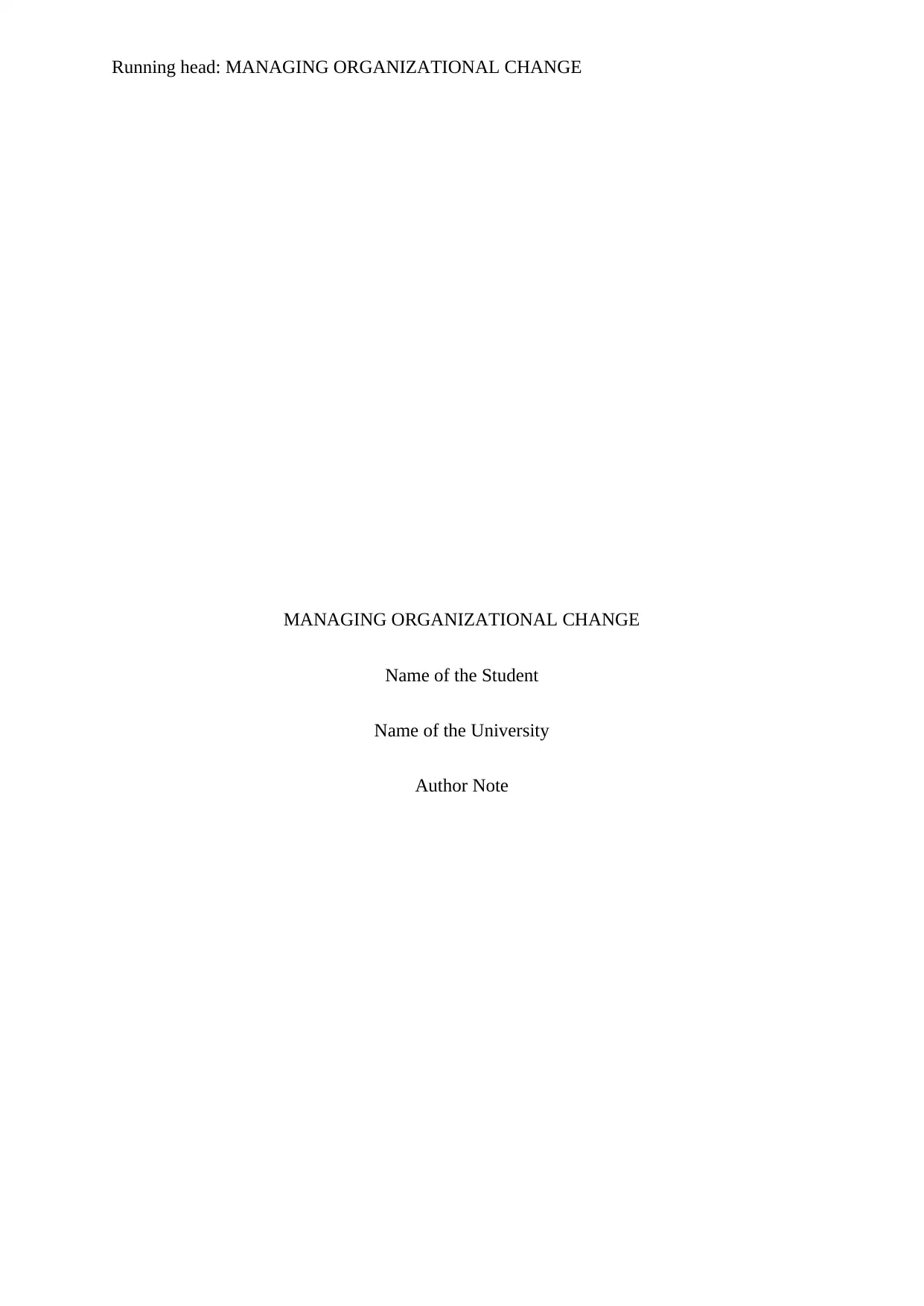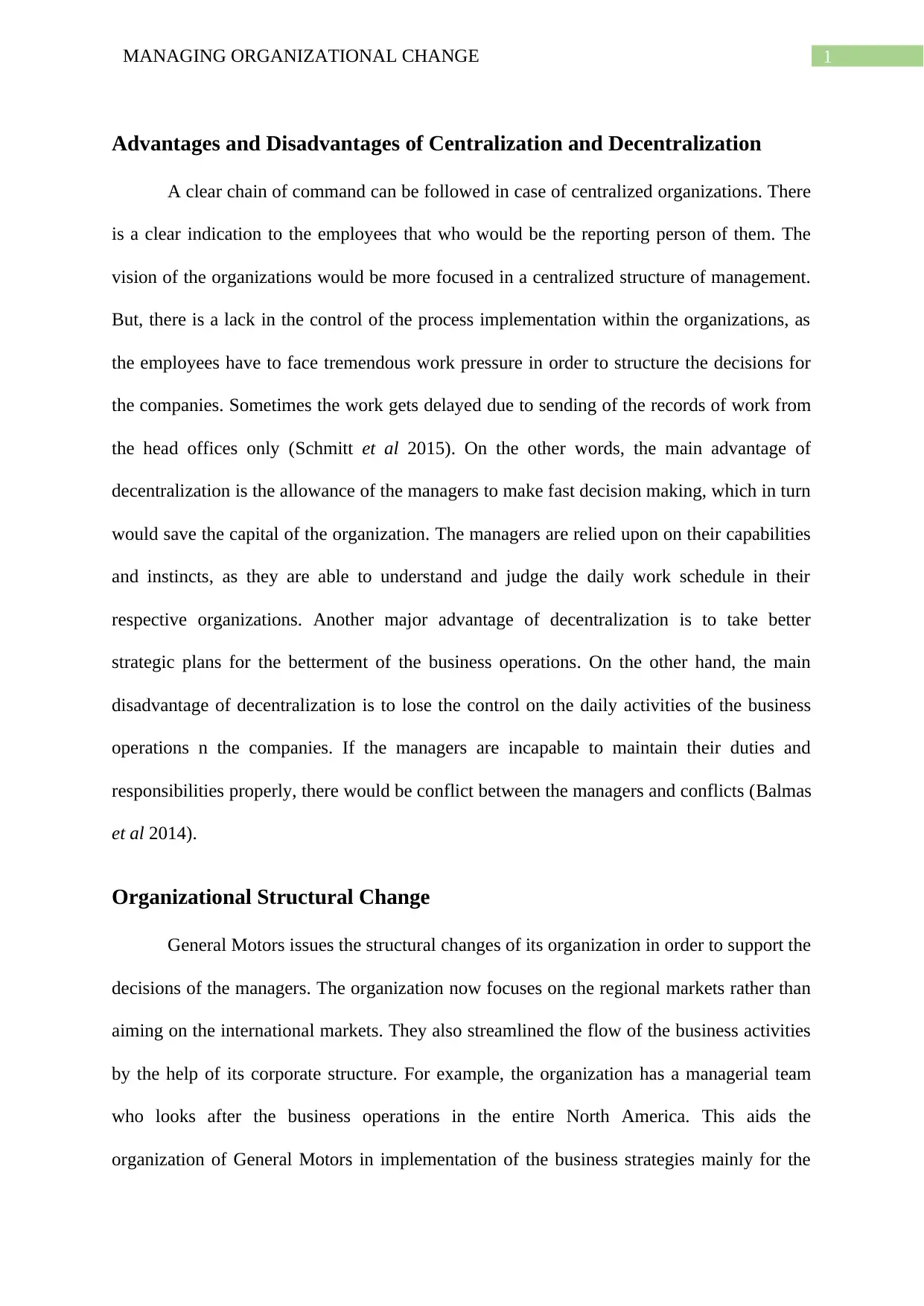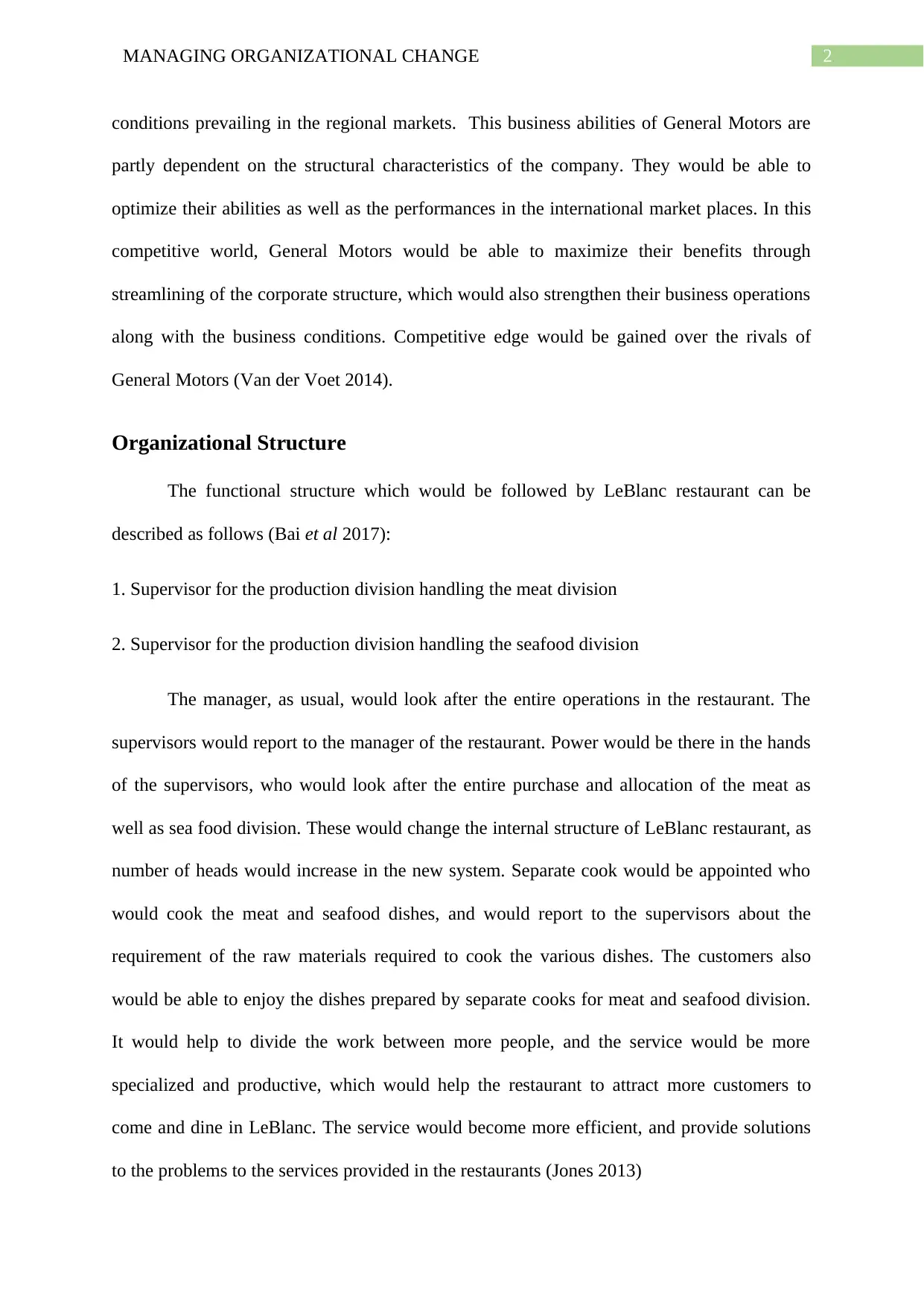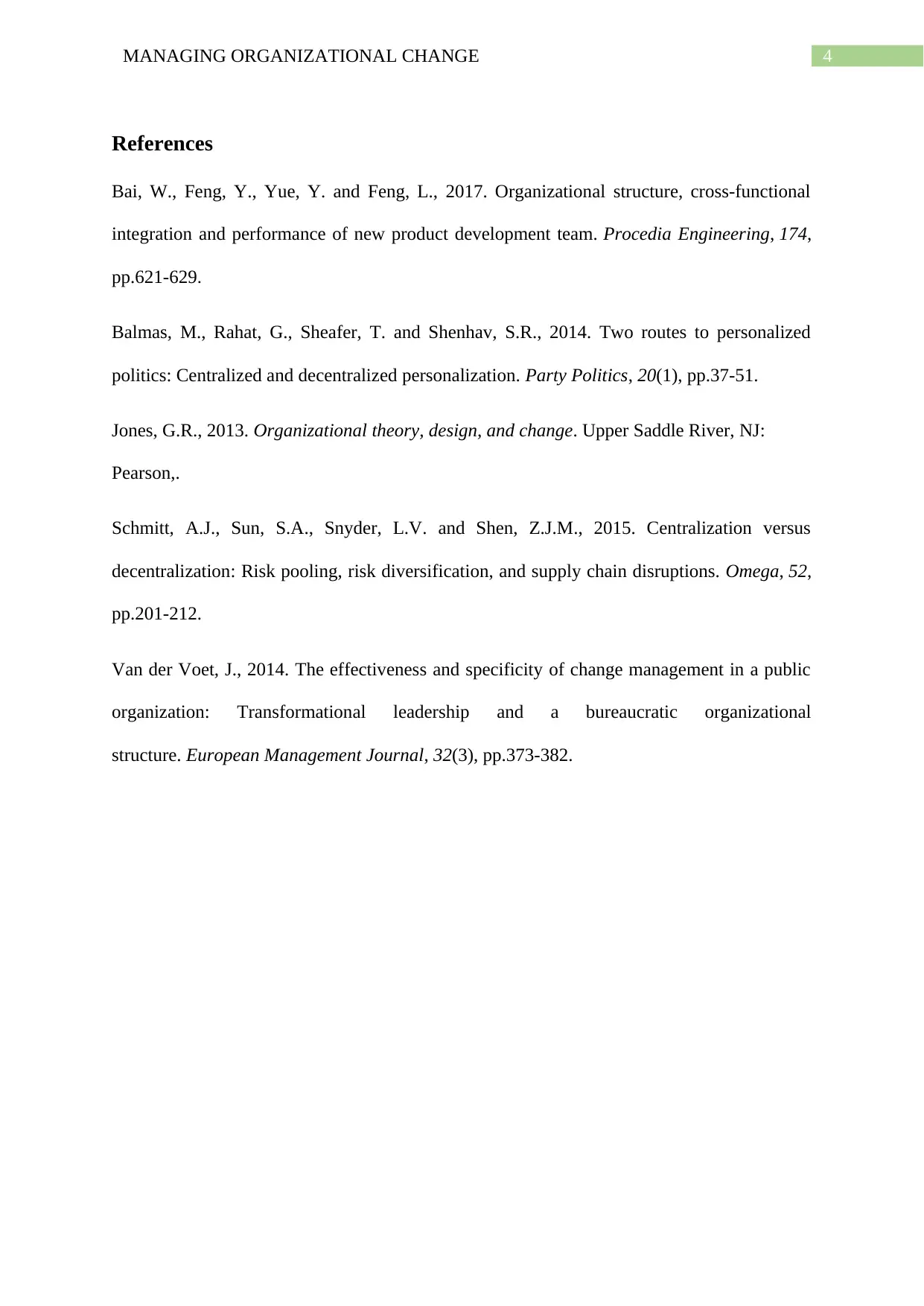Report on Managing Organizational Change and Structural Analysis
VerifiedAdded on 2022/11/15
|5
|885
|112
Report
AI Summary
This report delves into the intricacies of managing organizational change, exploring the advantages and disadvantages of centralization and decentralization within organizational structures. It examines how companies like General Motors implement structural changes to adapt to market demands, streamline operations, and gain a competitive edge. The report also analyzes the functional structure of LeBlanc restaurant, detailing the roles of supervisors and managers, and how these changes impact the efficiency and customer service. The analysis includes references to relevant literature, offering a comprehensive understanding of organizational theory, design, and change management strategies. The report highlights how organizational structure impacts business performance and the importance of adapting to market changes.

Running head: MANAGING ORGANIZATIONAL CHANGE
MANAGING ORGANIZATIONAL CHANGE
Name of the Student
Name of the University
Author Note
MANAGING ORGANIZATIONAL CHANGE
Name of the Student
Name of the University
Author Note
Paraphrase This Document
Need a fresh take? Get an instant paraphrase of this document with our AI Paraphraser

1MANAGING ORGANIZATIONAL CHANGE
Advantages and Disadvantages of Centralization and Decentralization
A clear chain of command can be followed in case of centralized organizations. There
is a clear indication to the employees that who would be the reporting person of them. The
vision of the organizations would be more focused in a centralized structure of management.
But, there is a lack in the control of the process implementation within the organizations, as
the employees have to face tremendous work pressure in order to structure the decisions for
the companies. Sometimes the work gets delayed due to sending of the records of work from
the head offices only (Schmitt et al 2015). On the other words, the main advantage of
decentralization is the allowance of the managers to make fast decision making, which in turn
would save the capital of the organization. The managers are relied upon on their capabilities
and instincts, as they are able to understand and judge the daily work schedule in their
respective organizations. Another major advantage of decentralization is to take better
strategic plans for the betterment of the business operations. On the other hand, the main
disadvantage of decentralization is to lose the control on the daily activities of the business
operations n the companies. If the managers are incapable to maintain their duties and
responsibilities properly, there would be conflict between the managers and conflicts (Balmas
et al 2014).
Organizational Structural Change
General Motors issues the structural changes of its organization in order to support the
decisions of the managers. The organization now focuses on the regional markets rather than
aiming on the international markets. They also streamlined the flow of the business activities
by the help of its corporate structure. For example, the organization has a managerial team
who looks after the business operations in the entire North America. This aids the
organization of General Motors in implementation of the business strategies mainly for the
Advantages and Disadvantages of Centralization and Decentralization
A clear chain of command can be followed in case of centralized organizations. There
is a clear indication to the employees that who would be the reporting person of them. The
vision of the organizations would be more focused in a centralized structure of management.
But, there is a lack in the control of the process implementation within the organizations, as
the employees have to face tremendous work pressure in order to structure the decisions for
the companies. Sometimes the work gets delayed due to sending of the records of work from
the head offices only (Schmitt et al 2015). On the other words, the main advantage of
decentralization is the allowance of the managers to make fast decision making, which in turn
would save the capital of the organization. The managers are relied upon on their capabilities
and instincts, as they are able to understand and judge the daily work schedule in their
respective organizations. Another major advantage of decentralization is to take better
strategic plans for the betterment of the business operations. On the other hand, the main
disadvantage of decentralization is to lose the control on the daily activities of the business
operations n the companies. If the managers are incapable to maintain their duties and
responsibilities properly, there would be conflict between the managers and conflicts (Balmas
et al 2014).
Organizational Structural Change
General Motors issues the structural changes of its organization in order to support the
decisions of the managers. The organization now focuses on the regional markets rather than
aiming on the international markets. They also streamlined the flow of the business activities
by the help of its corporate structure. For example, the organization has a managerial team
who looks after the business operations in the entire North America. This aids the
organization of General Motors in implementation of the business strategies mainly for the

2MANAGING ORGANIZATIONAL CHANGE
conditions prevailing in the regional markets. This business abilities of General Motors are
partly dependent on the structural characteristics of the company. They would be able to
optimize their abilities as well as the performances in the international market places. In this
competitive world, General Motors would be able to maximize their benefits through
streamlining of the corporate structure, which would also strengthen their business operations
along with the business conditions. Competitive edge would be gained over the rivals of
General Motors (Van der Voet 2014).
Organizational Structure
The functional structure which would be followed by LeBlanc restaurant can be
described as follows (Bai et al 2017):
1. Supervisor for the production division handling the meat division
2. Supervisor for the production division handling the seafood division
The manager, as usual, would look after the entire operations in the restaurant. The
supervisors would report to the manager of the restaurant. Power would be there in the hands
of the supervisors, who would look after the entire purchase and allocation of the meat as
well as sea food division. These would change the internal structure of LeBlanc restaurant, as
number of heads would increase in the new system. Separate cook would be appointed who
would cook the meat and seafood dishes, and would report to the supervisors about the
requirement of the raw materials required to cook the various dishes. The customers also
would be able to enjoy the dishes prepared by separate cooks for meat and seafood division.
It would help to divide the work between more people, and the service would be more
specialized and productive, which would help the restaurant to attract more customers to
come and dine in LeBlanc. The service would become more efficient, and provide solutions
to the problems to the services provided in the restaurants (Jones 2013)
conditions prevailing in the regional markets. This business abilities of General Motors are
partly dependent on the structural characteristics of the company. They would be able to
optimize their abilities as well as the performances in the international market places. In this
competitive world, General Motors would be able to maximize their benefits through
streamlining of the corporate structure, which would also strengthen their business operations
along with the business conditions. Competitive edge would be gained over the rivals of
General Motors (Van der Voet 2014).
Organizational Structure
The functional structure which would be followed by LeBlanc restaurant can be
described as follows (Bai et al 2017):
1. Supervisor for the production division handling the meat division
2. Supervisor for the production division handling the seafood division
The manager, as usual, would look after the entire operations in the restaurant. The
supervisors would report to the manager of the restaurant. Power would be there in the hands
of the supervisors, who would look after the entire purchase and allocation of the meat as
well as sea food division. These would change the internal structure of LeBlanc restaurant, as
number of heads would increase in the new system. Separate cook would be appointed who
would cook the meat and seafood dishes, and would report to the supervisors about the
requirement of the raw materials required to cook the various dishes. The customers also
would be able to enjoy the dishes prepared by separate cooks for meat and seafood division.
It would help to divide the work between more people, and the service would be more
specialized and productive, which would help the restaurant to attract more customers to
come and dine in LeBlanc. The service would become more efficient, and provide solutions
to the problems to the services provided in the restaurants (Jones 2013)
⊘ This is a preview!⊘
Do you want full access?
Subscribe today to unlock all pages.

Trusted by 1+ million students worldwide

3MANAGING ORGANIZATIONAL CHANGE
Paraphrase This Document
Need a fresh take? Get an instant paraphrase of this document with our AI Paraphraser

4MANAGING ORGANIZATIONAL CHANGE
References
Bai, W., Feng, Y., Yue, Y. and Feng, L., 2017. Organizational structure, cross-functional
integration and performance of new product development team. Procedia Engineering, 174,
pp.621-629.
Balmas, M., Rahat, G., Sheafer, T. and Shenhav, S.R., 2014. Two routes to personalized
politics: Centralized and decentralized personalization. Party Politics, 20(1), pp.37-51.
Jones, G.R., 2013. Organizational theory, design, and change. Upper Saddle River, NJ:
Pearson,.
Schmitt, A.J., Sun, S.A., Snyder, L.V. and Shen, Z.J.M., 2015. Centralization versus
decentralization: Risk pooling, risk diversification, and supply chain disruptions. Omega, 52,
pp.201-212.
Van der Voet, J., 2014. The effectiveness and specificity of change management in a public
organization: Transformational leadership and a bureaucratic organizational
structure. European Management Journal, 32(3), pp.373-382.
References
Bai, W., Feng, Y., Yue, Y. and Feng, L., 2017. Organizational structure, cross-functional
integration and performance of new product development team. Procedia Engineering, 174,
pp.621-629.
Balmas, M., Rahat, G., Sheafer, T. and Shenhav, S.R., 2014. Two routes to personalized
politics: Centralized and decentralized personalization. Party Politics, 20(1), pp.37-51.
Jones, G.R., 2013. Organizational theory, design, and change. Upper Saddle River, NJ:
Pearson,.
Schmitt, A.J., Sun, S.A., Snyder, L.V. and Shen, Z.J.M., 2015. Centralization versus
decentralization: Risk pooling, risk diversification, and supply chain disruptions. Omega, 52,
pp.201-212.
Van der Voet, J., 2014. The effectiveness and specificity of change management in a public
organization: Transformational leadership and a bureaucratic organizational
structure. European Management Journal, 32(3), pp.373-382.
1 out of 5
Related Documents
Your All-in-One AI-Powered Toolkit for Academic Success.
+13062052269
info@desklib.com
Available 24*7 on WhatsApp / Email
![[object Object]](/_next/static/media/star-bottom.7253800d.svg)
Unlock your academic potential
Copyright © 2020–2025 A2Z Services. All Rights Reserved. Developed and managed by ZUCOL.



